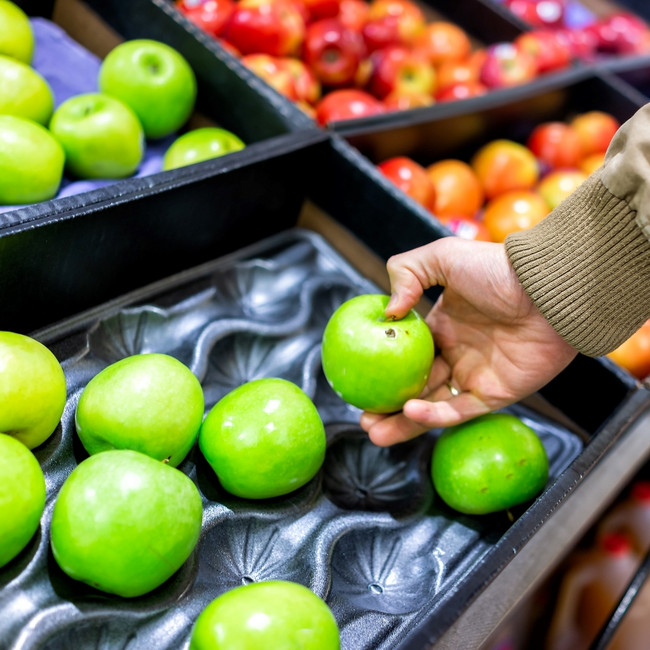✕



✕

Tag:Fungal strain Patulin toxicity Contamination 2023-09-06 10:34
Researchers have identified a species of fungus that transforms patulin, a dangerous mycotoxin sometimes found in fruits, into less toxic byproducts.
Patulin is a harmful mycotoxin produced by fungi typically found in damaged fruits, including apples, pears and grapes. The researchers say that the latest findings provide important insights into the degradation mechanisms for patulin found in nature and can lead to new ways of controlling patulin toxicity in our food supplies.
Patulin contamination
Patulin (C7H6O4), a mycotoxin produced by several types of fungi, is toxic to various life forms, including humans, mammals, plants and microorganisms.
In particular, environments lacking proper hygienic measures during food production are susceptible to patulin contamination. Many of these fungi species grow on damaged or decaying fruits, specifically apples and even contaminate apple products, such as apple sauce, apple juice, jams and ciders.
Responsible for various health hazards, including nausea, lung congestion, ulcers, intestinal hemorrhages and even more severe outcomes, such as DNA damage, immunosuppression and increased cancer risk, patulin toxicity is a serious concern worldwide. As a result, many countries have imposed restrictions on the permitted levels of patulin in food products, especially baby foods, as infants are more vulnerable to the effects of patulin.
Treatment of patulin toxicity includes oxygen therapy, immunotherapy, detoxification therapy and nutrient therapy. However, as prevention is often better than cure, scientists have sought efficient ways to mitigate patulin toxicity in food products.
Keeping patulin toxicity in check
To this end, a research team, including Associate Professor Toshiki Furuya from Tokyo University of Science (TUS) in Japan, recently screened for soil microorganisms that can potentially help keep patulin toxicity in check.

Patulin is a harmful mycotoxin produced by fungi typically found in damaged fruits, including apples.
The team cultured microorganisms from 510 soil samples in a patulin-rich environment, looking for those that would thrive in the presence of the toxin.
Next, in a second screening experiment, they used high-performance liquid chromatography (HPLC) to determine the survivors that were most effective in degrading patulin into other less harmful chemical substances. Accordingly, they identified a filamentous fungal (mold) strain, Acremonium sp. or “TUS-MM1,” belonging to the genera Acremonium, that fit the bill.
The team then performed various experiments to shed light on the mechanisms by which TUS-MM1 degraded patulin. This involved incubating the mold strain in a patulin-rich solution and focusing on the substances that gradually appeared inside and outside its cells in response to patulin over time.
Transforming cells
One important finding was that TUS-MM1 cells transformed any absorbed patulin into desoxypatulinic acid, a compound much less toxic than patulin, by adding hydrogen atoms to it.
“When we started this research, only one other filamentous fungal strain had been reported to degrade patulin,” comments Dr. Furuya. “However, no degradation products had ever been identified before the present study. To our knowledge, TUS-MM1 is the first filamentous fungus shown to be capable of degrading patulin into desoxypatulinic acid.”
Moreover, the team found that some of the compounds secreted by TUS-MM1 cells can also transform patulin into other molecules. By mixing patulin with the extracellular secretions of TUS-MM1 cells and using HPLC, they observed various degradation products generated from patulin.
Notably, experiments on E. coli bacterium cells revealed that these products are significantly less toxic than patulin itself. Through further chemical analyses, the team showed that the main agent responsible for patulin transformation outside the cells was a thermally stable but highly reactive compound with a low molecular weight.
Overall, the findings of this study take the researchers a step closer to efficient solutions for controlling the levels of patulin in food.
Dr. Furuya further speculates: “Elucidating the pathways via which microorganisms can degrade patulin would be helpful not only for increasing our understanding of the underlying mechanisms in nature but also for facilitating the application of these organisms in biocontrol efforts.”
Why Chardonnay Is The Best Wine To Pair With Lobster Rolls
Don't Go To A Brazilian Steakhouse Without Knowing How To Use The Table Cards
The Chef-Approved Ingredient That Thickens Runny Takeout Sauces
Cured Vs Uncured Hot Dogs: What's The Difference Between The Sausages?
Even Grilled Chicken Can Be Fall-Themed With The Right Ingredients
Give Store-Bought Honey Mustard A Restaurant-Quality Kick With One Ingredient
About Us Terms of Service Privacy Policy Contact Us
Hotline(+86)17301604571
 Enterprise WeChat
Enterprise WeChat
for Client Service
 EZBuy
EZBuy
WeChat APP
Sinoexpo Digital Platform
Shanghai Sinoexpo Informa Markets International Exhibition Co., Ltd. All rights reserved
沪ICP备05034851号-77
 沪公网安备31010402000543号
沪公网安备31010402000543号